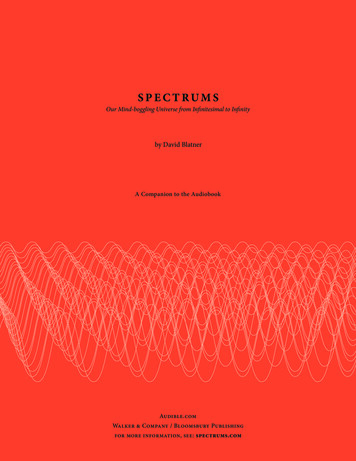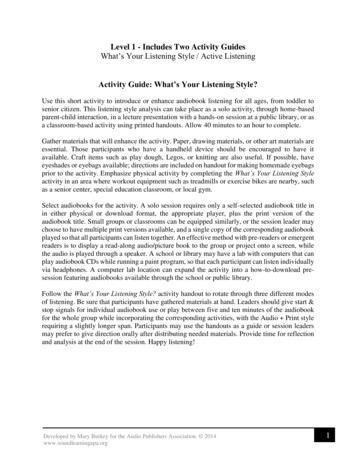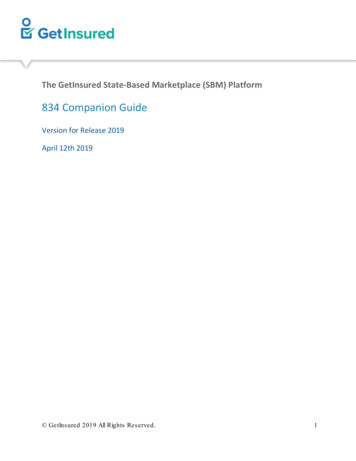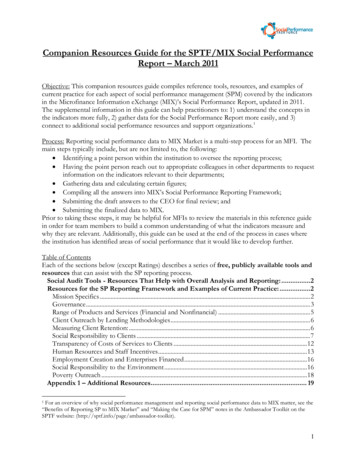
Transcription
SPECTRUMSOur Mind-boggling Universe from Infinitesimal to Infinityby David BlatnerA Companion to the AudiobookAudible.comWalker & Company / Bloomsbury Publishingmore information,Spectrums: Our Mind-Boggling Universe forFrom Infinitesimalto Infinity www.spectrums.com see: spectrums.comA companion to the audiobookPage 1
A NOTE ON THIS AUDIOBOOK COMPANIONThank you for listening to the audiobook edition of Spectrums: OurMind-Boggling Universe From Infinitesimal to Infinity. This companionbooklet includes a number of quotes, sidebars, and illustrations fromthe original print edition of the book, separated by chapter.In particular, note the table of prefixes on page 5, which explains thedifference between kilometers and micrometers, nanoseconds versusyottaseconds, and teragrams versus attograms.For additional information, facts, quotes, and insight, please visit thecompanion website: http://spectrums.comABOUT THE AUTHORDavid Blatner is known worldwide for his award-winning books,including The Joy of Pi and The Flying Book, and his lectures onelectronic publishing. More than a half-million copies of his books arein print in fourteen languages. He and his wife and two sons live outsideSeattle, Washington. You can learn more about David’s work at 63p.comor on twitter @dblatnerCopyright 2012–2015 by David Blatner, spectrums.comTo Gabriel and Daniel, who help me keep everything in perspectiveImages on pages 6, 7, and 11 courtesy of NASA and the NASA Earth ObservatoryOriginally published by Walker Publishing Company, Inc., New YorkA Division of Bloomsbury PublishingISBN 978-0-8027-1770-2 (hardback)Elements of this audiobook companion were originally designed by Scott CitronSpectrums: Our Mind-Boggling Universe From Infinitesimal to Infinity www.spectrums.com A companion to the audiobookPage 2
INTRODUCTIONI use the plural spectrums instead of spectra fora reason: While both are correct, the latterhas unfortunately gained the supernaturalconnotation of ghosts and spirits. Althoughspectrum, spectra, spectral, and specter all derivefrom the Latin word for “vision,” we often applythem to phenomena that have nothing to do withwhat we can see. This is similar to how, overthe last century, a number of words with rootsin science—such as dimension, evolution, andeven energy—have expanded their meanings farbeyond their original intention. Today, the wordspectrum indicates virtually any broad range ofcharacteristics or ideas.“ We don’t see thingsas they are, we seethem as we are.”—Anaïs Nin“ My task is toconvince younot to turn awaybecause it appearsincomprehensible . . .You see, my physicsstudents don’tunderstandit . . . becausethe professordoesn’t understandit. Nobody does.The thing that isexciting aboutthis is that natureis as strange ascan be! The rulesof nature are soscrewy you can’tbelieve them . . . Idon’t understand iteither! But the funof it is that it’s somysterious!” —Richard Feynman,Nobel Prize–winning physicist“ We don’t know amillionth of onepercent aboutanything.”—Thomas Edison“ Have you evernoticed thatanybody drivingslower than you isan idiot, and anyonegoing faster thanyou is a maniac?”—George Carlin“ Man is equallyincapable of seeingthe nothingnessfrom which heemerges and theinfinity in which heis engulfed.”Blaise Pascal, 17th-centurymathematicianSpectrums: Our Mind-Boggling Universe From Infinitesimal to Infinity www.spectrums.com A companion to the audiobookPage 3
CHAPTER 1: NUMBERSThere are more insects in asingle square mile of good,fertile soil than there arehuman beings on Earth.Each cell in the human bodycontains more atoms thanthere are stars in the MilkyWay galaxy.Three moles of water wouldfill about a quarter cup. Threemoles of M&M candies wouldfill all the oceans of the world.“ The number ofelectrons whichpass through thefilament of anordinary fifty-wattelectric lamp in aminute equals thenumber of drops ofwater that flow overNiagara Falls in acentury.”—Edward Kasner and JamesNewman, Mathematics and theImagination“ Instead of looking up at the‘big numbers,’ we can shrinkthem to our level. Imaginethe average person makes50k/year, and a rich guymakes 500k/year. What’sthe difference? Well, insteadof visualizing having 10 your money, imagine thatthings cost 10 times less. Anew laptop? That’ll be 150bucks. A new Porsche? Only6,000 dollars. A really nicehouse? 50k. Yowza. Thingsare cheap when you’re rich.To understand Bill Gates’scale, don’t think of 50 billiondollars and 5 billion/year“ Not everythingthat counts can becounted, and noteverything that canbe counted counts.”income—it’s just another—Albert Einsteinwould be about 60 cents.large number. Try to imaginehaving things cost 100,000times less . . . A laptop wouldbe a few pennies. A PorscheYour 50M mansion would bea mere 500 bucks.”—Kalid Azad,“How to Developa Sense of Scale”Spectrums: Our Mind-Boggling Universe From Infinitesimal to Infinity www.spectrums.com A companion to the audiobookPage 4
10,000 100 1,000,000 ( 1 million) 1,000,000,000 ( 1 billion)Illustration by Brad Krause, Radiance Media 1,000,000,000,000 ( 1 trillion)PrefixAbbreviation for MetersSizeNameyotta-Ym10septillions, from the Greek okto (“eight,” as this is the eighth group of thousands—that is, 1,0008)zetta-Zm1021sextillions, from the French sept (“seven”)exa-Em10quintillions, from the Greek hex (“six”)petatera-2418Pm1510quadrillions, from the Greek pente (“five”)Tm1012trillions, from the Greek teras (“monster”)giga-Gm109billions, from the Greek giga (“giant”)mega-Mm10millions, from the Greek word for “great” (Alexander the Great was Megas Alexandros)kilo-km10thousands, from the Greek khiloi (“thousand”); 1 mile equals 1.6 kmhecto-hm102hundreds, from the Greek hekaton (“hundred”)deca-dam10tens, from the Greek deka (“ten”)deci-dm10tenths, from the Latin decimus (“tenth”)centi-cm10–2hundredths, from the Latin centum (“hundred”)milli-mm10thousandths, from the Latin mille (“thousand”); 1 inch is about 25½ mmmicro-µm10millionths, from the Greek mikros (“small”); sometimes called micronsnano-nm10–9billionths, from the Latin nanus (“dwarf”)pico-pm10–12trillionths, from the Celtic beccus (“beak” or “sharp point”)femto-fm10quadrillionths, from the Danish femten (“fifteen”)atto-am10quintillionths, from the Danish atten (“eighteen”); note that an attometer is 1,000 zeptometers and azepto-zm10sextillionths, from the Latin septem (“seven,” as this is the seventh group of thousandths—that is, 1,000–7)yocto-ym10–24septillionths, from the Greek octo (“eight”)631–1–3–6–15–18thousandth of a femtometer–21Spectrums: Our Mind-Boggling Universe From Infinitesimal to Infinity www.spectrums.com A companion to the audiobookPage 5
CHAPTER 2: SIZEThe Washington Monument inD.C. was built in 1884 to be555 ft 5 in. (170 m) tall.EarthThe world record for theshortest human is held by the72-year-old Nepalese ChandraBahadur Dangi at 21.5 inches(54.6 cm) tall.The largest living thing onEarth: the 2,400-year-old,2,200-acre (8.9 km2) giantfungus living underground inOregon. Earth as a tiny dot of light, seen through the rings of Saturn from the Cassinispacecraft in 2006.“ Look again at that dot.That’s here. That’s home.The only countries thathaven’t standardized on themetric system are the UnitedStates, Myanmar, and Liberia.That’s us. On it everyoneyou love, everyone you know,everyone you ever heard of,every human being who everwas, lived out their lives . . .every king and peasant, everyFew Americans know thatAmerica has been debatingthe adoption of metricmeasurements for morethan 200 years. To arguethe use of meters vs. milesis as American as apple pieand George Washington, whobrought the discussion tothe public’s attention in hisfirst inaugural address. Evenfewer Americans know thateven the foot and yard arelegally based on the value ofthe meter. One yard equalsexactly 0.9144 meter.Spectrums: Our Mind-Boggling Universe From Infinitesimal to Infinity www.spectrums.com young couple in love, everymother and father, hopefulchild, inventor and explorer,every teacher of morals,every corrupt politician, every‘superstar,’ every ‘supremeleader,’ every saint andsinner in the history of ourspecies lived there—on amote of dust suspended in asunbeam.”—Carl SaganA companion to the audiobookPage 6
If our solar system (out tothe Oort cloud) were the sizeof a grain of salt, the MilkyWay galaxy would be aboutthe length of a football field.If the Milky Way galaxy werethe size of a grain of salt,the visible universe wouldbe about as large as the110-story Sears Tower inChicago.If the universe were shrunkso that Earth were the sizeof a period on this page, ournearest star would be 1,500km (930 mi) away. The centerof the Milky Way would beabout 8 Gm or 5 million milesaway.The “year” in “light-year” isthe Julian year, which isalways exactly 365.25 days of86,400 seconds each.If Earth were the size of abaseball sitting at home platein a baseball park, the moonwould be the size of a cherry,about 7.5 feet away. Mars isonly about a third of a mileaway. The sun would be 27feet across, three quarters ofa mile away. The next planetout, Jupiter, would be about 3miles away. At this scale, thenearest star outside our solarsystem would be located faroff any map of the world.If Earth were the size of agrain of sand in San Francisco,the nearest star (apartfrom our own sun) wouldbe the size of a peppercorn,hundreds of miles away, nearthe Grand Canyon. Sirius, thebrightest star in the nightsky, is as big as a baseball,halfway across the UnitedStates.One billionth: A nanometer isa billionth of a meter; a dime(or 1-yen coin) is about abillionth of the diameter ofEarth.“ Space is big. Reallybig. You just won’tbelieve how vastlyhugely mindbogglingly big itis. I mean, you maythink it’s a longway down the roadto the chemist, butthat’s just peanutsto space.”—Douglas Adams,The Hitchhiker’s Guideto the Galaxy“ The cells of ourbody are as smallrelative to our ownsize as a mountainis large.”—Christopher Potter,You Are HereThe ink that forms a singleletter A on this page containsenough atoms so that notonly could every person onEarth have one but also everyperson on every planet in theMilky Way, assuming everystar had a planet like ours. The top-left image, called the Hubble SpaceTelescope Ultra-Deep Field, represents a span thesize of a pen point against the night sky.Spectrums: Our Mind-Boggling Universe From Infinitesimal to Infinity www.spectrums.com A companion to the audiobookPage 7
CHAPTER 3: LIGHTIf you chew a Wint-O-GreenLife Saver in a darkroom, you can experiencetriboluminescence—generating light from crushing,rubbing, ripping, or scratching.All hard candy emits lightwhen broken, but becausewintergreen oil (methylsalicylate) is fluorescent,it converts the generatedultraviolet light into blue lightthat is easy to see. Quicklypull open a Band-Aid wrapper,or a piece of cloth frictiontape from a roll, and you’llsee a thin line of light appear.Pulling off a strip of Scotchtape generates X-rays sostrong that they can leave animage on dental photographicpaper.“ Light is not somuch somethingthat reveals, asit is itself therevelation.”“ It is sometimes saidthat scientists areunromantic, thattheir passion tofigure out robs theworld of beauty andmystery. But . . . itdoes no harm tothe romance of thesunset to know alittle bit about it.”—James Turrell, artist“ In the beginningthere was nothing.God said, ‘Let therebe light!’ And therewas light. Therewas still nothing,but you could see ita whole lot better.”—Carl Sagan—Ellen DeGeneres Visible light spectrumIncreasing Frequency (ƒ)102410221020gamma rays1018X 00v (Hz)Long radio wavesRadio 106108λ (m)Increasing Wavelength (λ)Visible Increasing Wavelength (λ) in nmSpectrums: Our Mind-Boggling Universe From Infinitesimal to Infinity www.spectrums.com A companion to the audiobookPage 8
CHAPTER 4: SOUNDA bullwhip snapped properlycreates a tiny sonic boomas the end of the whip (the“cracker”) quickly flips aroundfaster than the speed ofsound.“ There is geometryin the hummingof the strings,there is music inthe spacing of thespheres.”—PythagorasSound FrequencyFrequencySound phenomenon0.1–2 ThzSASER (sound laser, in development)1–20 MHzMedical ultrasound25–100 kHzBat sonar clicks40–50 kHzUltrasonic cleaning32.768 kHzQuartz timing crystal18–20 kHzUpper limit of human hearing4–5 kHzField cricket (Teleogryllus oceanicus)2048 HzC7 scientific scale, highest note of a sopranosinger (approximate)440 HzA4 American standard pitch, TV test patterntone435 HzA4 international pitch261.63 Hz“ Wherever we are,what we hear ismostly noise. Whenwe ignore it, itdisturbs us. Whenwe listen to it, wefind it fascinating.”—John Cage, composer“Middle C” (C4 in the American standard pitch)256 HzC4 scientific scale, typical fundamentalfrequency for female vocal cords128 HzC3 scientific scale, typical fundamentalfrequency for male vocal cords64 HzC2 scientific scale, lowest note of a basssinger (approximate)50 HzRuby-throated hummingbird in flight20–50 HzCat purr20 HzLower limit of human hearing17–30 HzBlue and fin whales are the loudest marinesound in this range1–5 HzTornadoesSpectrums: Our Mind-Boggling Universe From Infinitesimal to Infinity www.spectrums.com A companion to the audiobookPage 9
Many species have developedspecialized organs toproduce or detect sounds.Arthropods such as spidersand cockroaches havespecial hairs on their legsthat can sense sound. Theantennae of mosquitoesand many other insects cansense minute variations in airpressure. Honeybees appearto communicate throughthe buzzing vibrations oftheir wings; ants, crickets,and even some snakes andspiders stridulate (rub bodyparts together) to createchirps, clicks, or hisses. Someof these can be extremelyloud: The African cicada’ssound has been measured atover 105 dB!Intensity of Selected SoundsLoudness/Intensity (dB)Source 0Silence0–10Faintest noise humans can hear10–20Normal breathing in quiet room, rustling leaves20–30Whispering at 5 feet30–40Library or calm room40–50Quiet office, normal talking or residential area50–60Dishwasher, electric toothbrush, rainfall, sewing machine60–70Air conditioner, automobile interior, background music, normalconversation, TV, vacuum cleaner70–80Coffee grinder, freeway traffic, garbage disposal, hair dryer80–90*Blender, doorbell, food processor, lawn mower, machine tools, noisyrestaurant, whistling kettle90–100Shouted conversation, tractor, truck100–110Boom box, factory machinery, motorcycle, school dance, snowblower,snowmobile, subway train110–120Ambulance siren, car horn, chain saw, disco, jet plane on ramp, rockconcert, shouting in ear120–130Heavy machinery, pneumatic drills, stock car races, thunder (shortterm hearing damage)130–140Air raid siren, jackhammer (threshold of pain)140–150Jet airplane taking off150–160Artillery fire at 500 feet160–170Fireworks, handgun, rifle170–180Shotgun, stun grenade180–190Rocket launch, volcanic eruption194Spectrums: Our Mind-Boggling Universe From Infinitesimal to Infinity www.spectrums.com Theoretical limit for undistorted sound in airA companion to the audiobookPage 10
CHAPTER 5: HEATA bolt of lightning can reach50,000 F—hotter than thesurface of the sun—andpacks a punch between 100million and 1 billion volts.Each degree on theFahrenheit scale equals 5 9 ofa degree on the Celsius scale.That has the curious resultthat both scales converge at–40 degrees: –40 C –40 F.Because cold air containsless moisture, mountainranges in temperate areasreceive far more snow thanthe north or south poles.The Antarctic is essentially adesert, with extremely dry airand even less precipitationthan Phoenix, Arizona! The coldest known natural temperature in the universe is the BoomerangNebula, a bow-tie-shaped expulsion of gas from a dying star about 5,000 lightyears away in the constellation Centaurus. You’d expect an explosion like this togenerate huge quantities of heat, but in fact the extremely rapid expansion of thegas into space had just the opposite effect, acting like the expansion tube in arefrigerator and leading to a temperature of about 1 K.Spectrums: Our Mind-Boggling Universe From Infinitesimal to Infinity www.spectrums.com A companion to the audiobookPage 11
Spectrum of TemperatureAbsolute hot (Planck temperature) 1.42 1032 KMelting point of hadrons into quark-gluon plasma 2 trillion KEverything 1 second after big bang 10 billion KThermonuclear weapon peak 350 million CSun’s core 15 million C (27 million F)Lightning bolt 28,000 C (50,000 F)Center of Earth 6,650 C (12,000 F)Surface of sun 5,500 C (10,000 F)Filament inside light bulb 2,500 C (4,600 F)Natural gas (methane) flame on a stovetop 1,200 C (2,200 F)Lava 1,100 C (2,000 F)Wood fire 900 C (1,650 F)Draper point (where almost all solid materials begin to visibly glow) 525 C (977 F)Melting point of lead 328 C (621 F)Kitchen oven 288 C (550 F)Book cellulose-based paper burns 233 C (451 F)Water boils 100 C (212 F)Hottest shade temperature recorded on Earth 58 C (136 F)Human body temperature 37 C (98.6 F)Room temperature 20 C (68 F)Water freezes 0 C (32 F or 273 K)Mercury in a thermometer freezes –39 C (–38 F)Coldest temperature recorded on Earth –89 C (–129 F)Alcohol freezes –114 C (–173 F)Gasoline freezes –150 C (–238 F)Boiling temperature of oxygen –183 C (–298 F)Temperature on Neptune –220 C (–364 F)Coldest spot on moon –228 C (–378 F or 45 K)Cosmic microwave background 2.725 KColdest natural temperature known (Boomerang Nebula) 1 KColdest measured temperature 100 pKAbsolute zero 0 K (–273.16 C or –495.67 F)Spectrums: Our Mind-Boggling Universe From Infinitesimal to Infinity www.spectrums.com A companion to the audiobookPage 12
CHAPTER 6: TIMEπ times 107 seconds is agood approximation of oneyear (it’s 363.6 days). Evenbetter is taking the squareroot of 10, then multiplying by10 million seconds (almostexactly 366 days). But πx 1016 seconds is about 1billion years (an eon).You know that each fouryears is a leap year andyou have to add a leap day,February 29. And you mayknow that you have to omitthat extra day every 100years. But do you know thatyou have to put it back inevery 400 years? That’s why2000 was a leap year but1900 was not. And don’tforget to remove the leapday every 4,000 years, orreintroduce it in each centuryyear that, when divided by900, leaves a remainder of200 or 600.“ Which is quicker, ajiffy or a flash? Ithink there are twoflashes in a jiffy,myself. But Godknows how manyjiffies there are intwo shakes of alamb’s tail. But whydid they use twoshakes of a lamb’stail? What’s wrongwith the basic unitof measurement,one shake of alamb’s tail? Wecan do our ownarithmetic, thankyou.”—Delmore Schwartz, “Calmly WeWalk Through This April’s Day”“ Time is an illusion.Lunchtime doublyso.”—Douglas Adams, novelistThe individual H2O moleculesin water have a slightattraction to each other,bonding for just a fewpicoseconds at a time. It’slike a disco dance floor ofconstant movement, wheremolecules partner off, thenbreak up and dance withothers—the attractions keepit tight enough to form a mobbut loose enough so thatforeign molecules can easilywander through the liquid.CIA World FactbookIf you compressed the age ofthe universe into a single day,the average human life spanwould take only 1/2,000 of asecond.—George Carlin“ Time is the fire inwhich we burn.”Spectrums: Our Mind-Boggling Universe From Infinitesimal to Infinity www.spectrums.com A companion to the audiobookPage 13
The 24 world time zonesrarely follow straight lines. Stripesindicate regions that are ½ hourdifferent.The oldest living individualorganism on Earth is aGreat Basin bristlecone pinetree (Pinus longaeva) in themountains between Californiaand Nevada. It is 4,842 yearsold, based on a ring count of asample core. This tree, knownas Methuselah, was morethan two centuries old whenthe Great Pyramid of Giza wasconstructed. If you includeplants that clone themselves,the longest-living organismmay be a single clonal colonyof Populus tremuloides(quaking aspen) in Utah thathas been growing for anestimated 80,000 years.The special theory ofrelativity states that anobject would require aninfinite amount of energy inorder to accelerate to thespeed of light. But it doesn’tactually preclude things thatare already faster than thespeed of light. Some theoristsbelieve subatomic particlescalled tachyons may exist thatcan travel only at superluminalspeeds, not slower.“ Time is thesubstance fromwhich I am made.Time is a river whichcarries me along,but I am the river;it is a tiger thatdevours me, but Iam the tiger; it is afire that consumesme, but I am thefire.”—Jorge Luis Borges, “A NewRefutation of Time”A clock at the top of Mt.Everest will pull ahead ofone at sea level by about 30microseconds per year.Spectrums: Our Mind-Boggling Universe From Infinitesimal to Infinity www.spectrums.com A companion to the audiobookPage 14
SpeedFingernails grow1.2 10–9 m/s (2.6 10–9 mph)Moon receding from Earth1.3 10–9 m/s (about 1 nm/s)Average growth rate of child1.8 10–9 m/s (4 10–9 mph)Growth rate of bamboo6 10–7 m/s (1.3 10–6 mph)Garden snail0.002 m/s (0.004 mph)Audiocassette tape speed0.0476 m/s (0.106 mph)One knot (nautical mile per hour)1.852 km/h (1.151 mph)Average walking speed1.2 m/s (2.5 mph)World record swimming2.3 m/s (5.2 mph)Comfortable bicycling speed6 m/s (13 mph)Fastest human running12 m/s (27 mph)Horse in gallop13 m/s (30 mph)Object falling 10 m14 m/s (31 mph)Sky-diver in midflightSneeze54 m/s (120 mph)up to 46 m/s (104 mph)Golf ball driven off tee, arrow fired from longbow60 m/s (130 mph)Stock car90 m/s (200 mph)Wind in tornado112 m/s (250 mph)Fastest train with wheels (non-maglev)160 m/s (357 mph).22 long-range centerfire bullet400 m/s (1,300 ft/sec, or 895 mph)Earth’s rotation at equator464 m/s (1,038 mph)SR-71 Blackbird, fastest jet aircraft981 m/s (2,194 mph)North American X-15 rocket-powered aircraft2,020 m/s (4,519 mph)Satellite in geosynchronous orbit3,100 m/s (6,900 mph)Space shuttle, and International Space Station in orbit7,743 m/s (17,320 mph)Apollo 10 manned spacecraft, return trip from moon11 km/s (24,791 mph)Earth orbits the sun30 km/s (66,620 mph)Helios space probe (orbiting the sun)Solar system orbiting the Milky WayMilky Way moving through space (relative to cosmic background radiation)Rotation of fast neutron starLight in a vacuumSpectrums: Our Mind-Boggling Universe From Infinitesimal to Infinity www.spectrums.com 70.22 km/s (157,078 mph)216 km/s (483,000 mph)550 km/s (1.2 million mph)38 Mm/s299,792,458 m/s (186,282 mi/sec)A companion to the audiobookPage 15
AND, IN CONCLUSION “ I regardconsciousness asfundamental.I regard matteras derivative fromconsciousness. Wecannot get behindconsciousness.Everything thatwe talk about,everything thatwe regard asexisting, postulatesconsciousness.”“ Science cannotsolve the ultimatemystery of nature.And it is because,in the last analysis,we ourselves arepart of the mysterywe are trying tosolve.”“ Penetrating somany secrets, wecease to believein the unknowable.But there it sitsnevertheless, calmlylicking its chops.”—H. L. Mencken, satirist—Max Planck, physicist—Max Planck, physicist“ Even though youcan’t see or hearthem at all, aperson’s a person,no matter howsmall.”—Dr. Seuss, Horton Hears a Who!FOR FURTHER READINGFor additional links, facts, and information, visit: www.spectrums.comSelected BooksAsimov, Isaac. The Measure of the Universe: Our Foremost Science Writer Looks at the World Large and Small.New York: Harper and Row, 1983.Carroll, Sean. From Eternity to Here: The Quest for the Ultimate Theory of Time. New York: Dutton, 2010.Davies, Paul. The Goldilocks Enigma: Why Is the Universe Just Right for Life? New York: Mariner Books, 2008.Greene, Brian. The Fabric of the Cosmos: Space, Time, and the Texture of Reality. New York: Vintage, 2005.Joseph, Christopher. A Measure of Everything: An Illustrated Guide to the Science of Measurement. Ontario: Firefly Books, 2006.Kaku, Michio. Hyperspace: A Scientific Odyssey Through Parallel Universes, Time Warps, and the 10th Dimension. New York: Anchor, 1995.Potter, Christopher. You Are Here: A Portable History of the Universe. New York: Harper Perennial, 2010.Robinson, Andrew. The Story of Measurement. New York: Thames & Hudson, 2007.Streever, Bill. Cold: Adventures in the World’s Frozen Places. New York: Back Bay, 2010.Spectrums: Our Mind-Boggling Universe From Infinitesimal to Infinity www.spectrums.com A companion to the audiobookPage 16
Spectrums: Our Mind-Boggling Universe From Infinitesimal to Infinity A companion to the audiobook www.spectrums.com Page 6 The only countries that haven’t standardized on the metric system are the United States, Myanmar, and Liberia. Few Americans know that America has been debating the adoption of metr










